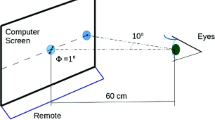Abstract
Three experiments are reported with two types of manipulations that are known to affect the latency with which subjects can initiate saccadic eye movements. The first manipulation involves the temporal relation between the offset of a visual fixation point and the onset of a peripheral target (the “gap effect”). The second manipulation involves the prior allocation and removal of visual attention (“inhibition of return”). In two experiments, the gap effect was smaller for saccades to previously attended locations than to previously unattended locations. The results suggest an important link between the two phenomena and provide new insights into the brain mechanisms underlying visual attention and eye movements.
Similar content being viewed by others
References
Abrams RA, Balota DA (1991) Mental chronometry: beyond reaction time. Psychol Sci 2:153–157
Abrams RA, Dobkin RS (in press) Inhibition of return: effects of attentional cuing on eye movement latencies. J Exp Psychol (Hum Percept)
Abrams RA, Meyer DE, Kornblum S (1989) Speed and accuracy of saccadic eye movements: characteristics of impulse variability in the oculomotor system. J Exp Psychol (Hum Percept) 15:529–543
Abrams RA, Dobkin RS, Helfrich MK (1992) Adaptive modification of saccadic eye movements. J Exp Psychol (Hum Percept) 18:922–933
Fischer B, Breitmeyer B (1987) Mechanisms of visual attention revealed by saccadic eye movements. Neuropsychologia 25:73–83
Fischer B, Ramsperger E (1984) Human express saccades: extremely short reaction times of goal directed eye movements. Exp Brain Res 57:191–195
Fischer B, Weber H (1993) Express saccades and visual attention. Behav Brain Sci 16:553–610
Goldberg ME, Bushnell MC, Bruce CJ (1986) The effect of attentive fixation on eye movements evoked by electrical stimulation of the frontal eye fields. Exp Brain Res 61:579–584
Kingstone A, Klein R (1993a) What are human express saccades? Percept Psychophys 54:260–273
Kingstone A, Klein R (1993b) Visual offsets facilitate saccadic latency: does pre-disengagement of visuospatial attention mediate this gap effect? J Exp Psychol (Hum Percept) 19:1251–1265
Maylor EA (1985) Facilitatory and inhibitory components of orienting in visual space. In: Posner MI, Marin O (eds) Attention and performance, vol XL Erlbaum, Hillsdale, NJ, pp 189–207
McClelland JL (1979) On the time relations of mental processes: an examination of systems of processes in cascade. Psychol Rev 86:287–330
Munoz DP, Wurtz RH (1992) Role of the rostral superior colliculus in active visual fixation and execution of express saccades. J Neurophysiol 67:1000–1002
Posner M, Cohen Y (1984) Components of visual orienting. In: Bouma H, Bouwhuis DG (eds) Attention and performance, vol X. Erlbaum, Hillsdale, NJ, pp 531–556
Posner MI, Rafal RD, Choate LS, Vaughan J (1985) Inhibition of return: neural basis and function. Cognitive Neuropsychol 2:211–228
Rafal R, Calabresi P, Brennan C, Sciolto T (1989) Saccade preparation inhibits reorienting to recently attended locations. J Exp Psychol (Hum Percept) 15:673–685
Reulen JPH (1984) Latency of visually evoked saccadic eye movements. I. Saccadic latency and the facilitation model. Biol Cybern 50:251–263
Reuter-Lorenz PA, Hughes HC, Fendrich R (1991) The reduction of saccadic latency by prior offset of the fixation point: an analysis of the gap effect. Percept Psychophys 49:167–175
Saslow MG (1967) Effects of components of displacement-step stimuli upon latency of saccadic eye movement. J Opt Soc Am 57:1024–1029
Schiller PH, Sandell JH, Maunsell JHR (1987) The effect of frontal eye field and superior colliculus lesions on saccadic latencies in the rhesus monkey. J Neurophysiol 57:1033–1049
Sparks DL, Mays LE (1983) Spatial localization of saccade targets. I. Compensation for stimulation-induced perturbations in eye position. J Neurophysiol 49:45–63
Sternberg S (1969) The discovery of processing stages: extensions of Donders' method. In: Koster WG (ed) Attention and performance, vol II North-Holland, Amsterdam, pp 276–315
Tipper SP, Weaver B, Jerreat LM, Burak AL (in press) Object-and environment-based inhibition of return of visual attention. J Exp Psychol (Hum Percept)
Vaughan J (1984) Saccades directed at previously attended locations in space. In: Gale AG, Johnson F (eds) Theoretical and applied aspects of eye movement research. North-Holland, Amsterdam, pp 143–150
Author information
Authors and Affiliations
Rights and permissions
About this article
Cite this article
Abrams, R.A., Dobkin, R.S. The gap effect and inhibition of return: interactive effects on eye movement latencies. Exp Brain Res 98, 483–487 (1994). https://doi.org/10.1007/BF00233985
Received:
Accepted:
Issue Date:
DOI: https://doi.org/10.1007/BF00233985




